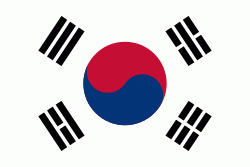Gimpo International Airport (Gimpo International Airport)
Gimpo International Airport (sometimes referred to as Seoul–Gimpo International Airport), formerly rendered in English as Kimpo International Airport, is located in the far western end of Seoul, some 15 km west of the Central District of Seoul. Gimpo was the main international airport for Seoul and South Korea before being replaced by Incheon International Airport in 2001. It now functions as Seoul's secondary airport. In 2015, over 23 million passengers used the airport, making it the third-largest airport in Korea, as it has been surpassed by Jeju International Airport.
The airport is located south of the Han River in western Seoul. The name "Gimpo" comes from the nearby city of Gimpo, of which the airport used to be a part.
On 29 November 2003, scheduled services between Gimpo and Haneda Airport in Tokyo resumed. Services to Shanghai Hongqiao International Airport resumed on 28 October 2007. Services to Kansai International Airport in Osaka, Japan, started on 26 October 2008 with services also operating at Incheon Airport. Services to Beijing Capital International Airport started on 1 July 2011 with services also operating at Incheon Airport. Services to Taipei Songshan Airport started on 30 April 2012.
The airfield was built in 1939 during the Japanese Imperial period as an Imperial Army base. The runways were built on a bed of rocks manually hauled by Korean laborers from Kaihwasan and Yangchan, several miles from the base. Then known as Keijo New Airfield (京城新飛行場), Kimpo was constructed with four runways to supplement the much smaller Keijo Airfield (京城飛行場), which was later known as Yeouido Airport.
The airport is located south of the Han River in western Seoul. The name "Gimpo" comes from the nearby city of Gimpo, of which the airport used to be a part.
On 29 November 2003, scheduled services between Gimpo and Haneda Airport in Tokyo resumed. Services to Shanghai Hongqiao International Airport resumed on 28 October 2007. Services to Kansai International Airport in Osaka, Japan, started on 26 October 2008 with services also operating at Incheon Airport. Services to Beijing Capital International Airport started on 1 July 2011 with services also operating at Incheon Airport. Services to Taipei Songshan Airport started on 30 April 2012.
The airfield was built in 1939 during the Japanese Imperial period as an Imperial Army base. The runways were built on a bed of rocks manually hauled by Korean laborers from Kaihwasan and Yangchan, several miles from the base. Then known as Keijo New Airfield (京城新飛行場), Kimpo was constructed with four runways to supplement the much smaller Keijo Airfield (京城飛行場), which was later known as Yeouido Airport.
| IATA Code | GMP | ICAO Code | RKSS | FAA Code | |
|---|---|---|---|---|---|
| Telephone | 82-2-2660-2114 | Fax | |||
| Home page | Hyperlink |
Map - Gimpo International Airport (Gimpo International Airport)
Map
Country - South_Korea
 |
 |
| Flag of South Korea | |
The Korean Peninsula was inhabited as early as the Lower Paleolithic period. Its first kingdom was noted in Chinese records in the early 7th century BCE. Following the unification of the Three Kingdoms of Korea into Silla and Balhae in the late 7th century, Korea was ruled by the Goryeo dynasty (918–1392) and the Joseon dynasty (1392–1897). The succeeding Korean Empire (1897–1910) was annexed in 1910 into the Empire of Japan. Japanese rule ended following Japan's surrender in World War II, after which Korea was divided into two zones; a northern zone occupied by the Soviet Union and a southern zone occupied by the United States. After negotiations on reunification failed, the southern zone became the Republic of Korea in August 1948 while the northern zone became the communist Democratic People's Republic of Korea the following month.
Currency / Language
| ISO | Currency | Symbol | Significant figures |
|---|---|---|---|
| KRW | South Korean won | â‚© | 0 |
| ISO | Language |
|---|---|
| EN | English language |
| KO | Korean language |















